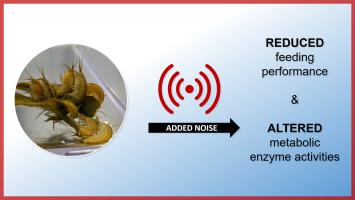噪声水体影响中食草类片脚类动物的摄食和代谢酶活性
IF 4.9
3区 环境科学与生态学
Q1 ENVIRONMENTAL SCIENCES
引用次数: 0
摘要
尽管大多数后生动物利用声音或振动来进行种内和种间的相互作用以及定位,但人为噪声逐渐侵入自然海洋声景的后果在很大程度上是未知的。特别是沿海生态系统,其特点是人类活动水平高,因此是人为噪声源。在这里,我们研究了这种噪音对海洋中食草动物的影响,这些小型无脊椎动物通过控制大型植物的生长发挥重要的生态作用,同时也是藻类主导的沿海生态系统中更高营养水平的主要食物来源。在实验室条件下,研究了连续低频噪声对中食草片足类Marinogammarus marinus生境选择、摄食率和代谢酶活性的影响。虽然栖息地选择似乎不受噪音的影响,但暴露的动物表现出摄食性能下降以及代谢酶活性改变。如果这种情况持续下去,可能会危及海蛸的生理稳态及其在生态系统中的作用。因此,海洋中不断上升的声音水平可能会对沿海地区以藻类为主的动物群落产生影响。本文章由计算机程序翻译,如有差异,请以英文原文为准。

Noisy waters affect feeding and metabolic enzyme activities of amphipod mesograzers
The consequences of the progressive intrusion of anthropogenic noise into natural oceanic soundscapes are largely unknown despite the fact that most metazoans utilize sound or vibration for intra- and interspecific interactions as well as orientation. Coastal ecosystems in particular can be characterized by a high level of human activity and thus anthropogenic noise sources. Here, we studied the impact of such noise on marine mesograzers, small invertebrates that play crucial ecological roles by controlling macrophyte growth while serving as key food sources for higher trophic levels in algae-dominated coastal ecosystems. The effect of added continuous low-frequency noise on the habitat choice, feeding rate, and metabolic enzyme activities of the amphipod mesograzer Marinogammarus marinus was tested in a controlled laboratory setting. While habitat choice appeared unaffected by the added noise, exposed animals exhibited reduced feeding performance as well as altered metabolic enzyme activities. If sustained, the physiological homeostasis of M. marinus and their role in the ecosystem may be jeopardized. The ever-rising sound levels in the oceans may thus have consequences for algae-dominated animal communities in coastal areas.
求助全文
通过发布文献求助,成功后即可免费获取论文全文。
去求助
来源期刊

Marine pollution bulletin
环境科学-海洋与淡水生物学
CiteScore
10.20
自引率
15.50%
发文量
1077
审稿时长
68 days
期刊介绍:
Marine Pollution Bulletin is concerned with the rational use of maritime and marine resources in estuaries, the seas and oceans, as well as with documenting marine pollution and introducing new forms of measurement and analysis. A wide range of topics are discussed as news, comment, reviews and research reports, not only on effluent disposal and pollution control, but also on the management, economic aspects and protection of the marine environment in general.
 求助内容:
求助内容: 应助结果提醒方式:
应助结果提醒方式:


